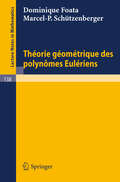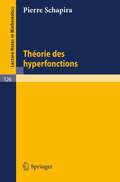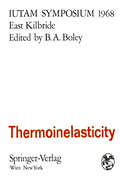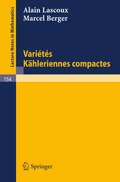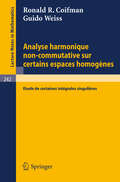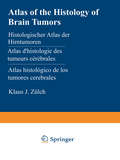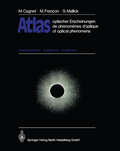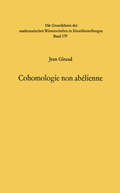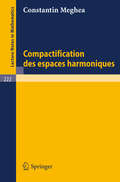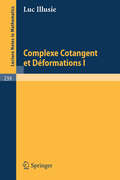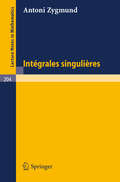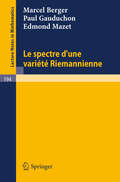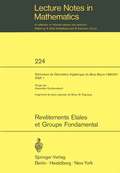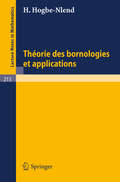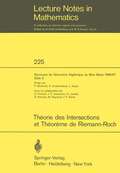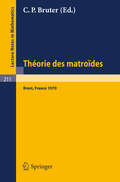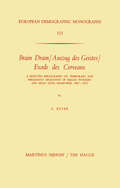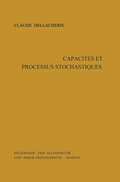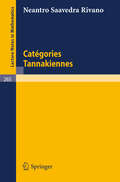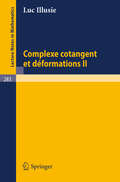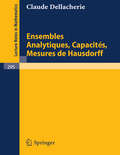- Table View
- List View
Theorie Geometrique des Polynomes Euleriens (Lecture Notes in Mathematics #138)
by Dominique Foata Marcel-P. SchützenbergerThermoinelasticity: Symposium East Kilbride, June 25–28, 1968 (IUTAM Symposia)
by Bruno A. BoleyThe proposal for a Symposium on high temperature effects in solids originated in 1964, at which time a pilot committee, headed by Professor F. K. G. ODQVIST, was formed. Upon the recommendation of this com mittee, a site for the Symposium and a Scientific Organizing Committee were chosen, and some guidelines delineating the field to be covered were established. The Symposium was held at the National Engineering Laboratory in East Kilbride (Glasgow), Scotland, from June 25 to 28, 1968. The Scientific Organizing Committee was composed of the following mem bers: Professor B. A. BOLEY, Chairman (U. S. A.) Professor F. BUCKENS (Belgium) Professor F. K. G. ODQVIST (Sweden) Professor W. OLSZAK (Poland) Professor H. PARKUS (Austria) Dr. D. G. SOPWITH (U. K.) The Local Organizing Committee was subsequently formed; it was direct ed by Dr. SOPWTTH with Mr. R. BRODIE as Secretary, and Mr. C. E. PHILLIPS and Dr. J. GLEN as additional members. It deserves ample praise for excellent arrangements and hospitality. In the discussions concerned with the goals of the Symposium, it was decided that its principal aim should be the presentation of a comprehen sive view of the behavior of solids and structures at high temperature under any type of inelastic regime. It soon became apparent that this was a very wide field, since it would embrace questions ranging from those of basic thermodynamic to those of engineering analysis and design.
Analyse Harmonique Non-Commutative sur Certains Espaces Homogènes: Etude de Certaines Intégrales Singulières (Lecture Notes in Mathematics #242)
by R. R. Coifman G. WeissAtlas of the Histology of Brain Tumors / Histologischer Atlas der Hirntumoren / Atlas d’histologie des tumeurs cérébrales / Atlas histológico de los tumores cerebrales / Гистологический атлас опухолей мозга человека: (pdf)
by K. J. ZülchAtlas optischer Erscheinungen / Atlas de phénomènes d’optique / Atlas of Optical Phenomena: Ergänzungsband · Supplément · Supplement
by Michel Cagnet M. Francon S. MallickCohomologie non abelienne (Grundlehren der mathematischen Wissenschaften #179)
by Jean GiraudNow a common tool and object of study, stacks were introduced in this book as a framework for the study of non-abelian cohomology classes in degrees 1 and 2 on an arbitrary topos. The book shows that these cohomology classes can be represented by geometric objects called torsors and gerbes, and provides a detailed study of their basic properties. Since their introduction in this book, gerbes have become a widespread tool in geometry and topology. A timeless classic, this French language book remains to this day a key reference for fibred categories, stacks, torsors, gerbes and topos.
Instability of Continuous Systems: Symposium Herrenalb (Germany) September 8–12, 1969 (IUTAM Symposia)
by Horst LeipholzUntil recently there was no uniform stability theory. Different approaches to stability problems had been developed in the different branches of mechanics. In the field of elasticity, it was mainly the so called static method and energy method which were used, while in the field of dynamics it was the kinetic method, which found its perfect expression in the theory of Liapunov. During the last few decades there has been a rapid development in the general theory of stability, stimulated, for example, by the investigations of H. ZIEGLER on elastic systems subject to non-conservative loads, and by the problems arising in aeroelasticity which are closely related to those introduced by ZIEGLER. The need was felt for kinetic methods which could also be used in investigating the stability of deformable systems. Efforts were made to adapt such methods, already known and developed in the stability theory of rigid systems, for application in the stability theory of continuous systems. During the last ten years interest was focused mainly on the application of a generalized Liapunov method to stability problems of continuous systems. All this was done in attempts to unify the various approaches to stability theory. It was with the idea of encouraging such a tendency, establishing to what extent a uniform physical and mathematical foundation already existed for stability theory in all branches of mechanics, and stimulating the further deve lopment of a common stability theory, that a IUTAM-Symposium was devoted to this topic.
Le Spectre d`une Variete Riemannienne (Lecture Notes in Mathematics #194)
by Marcel Berger Paul Gauduchon Edmond MazetRevêtements Étales et Groupe Fondamental: Séminaire de Géométrie Algébrique du Bois Marie 1960/61 (SGA 1) (Lecture Notes in Mathematics #224)
by Michèle RaynaudThéorie des Intersections et Théorème de Riemann-Roch: Séminaire de Géométrie Algébrique du Bois Marie 1966 /67 (SGA 6) (Lecture Notes in Mathematics #225)
by Pierre Berthelot D. Ferrand Alexander Grothendieck Jean-Pierre Jouanolou O. Jussila Luc Illusie S. Kleiman M. Raynaud Jean-Pierre SerreTheorie des Matroides: Rencontre Franco-Britannique, Actes 14-15 Mai 1970 (Lecture Notes in Mathematics #211)
by C. P. BruterBrain Drain / Auszug des Geistes / Exode des Cerveaux: A Selected Bibliography on Temporary and Permanent Migration of Skilled Workers and High-Level Manpower, 1967–1972 (European Demographic Monographs #3)
by G. BeyerIn 1967 S. Dedijer and L. Svennigson published their famous bibliography Brain Drain and Brain Gain, (Lund, 1968, index of authors, countries and regions). It contained 415 items from 40 countries and appeared at a time when the debate about the ad vantages and disadvantages of the brain drain was at its most intense. But the brain drain is still not a thing of the past - certain ly not for Europe. The European countries and those of the rest of the world are in different stages of transition. Industrialization has generally been associated, on the one hand with ever more rapid forms of trans portation and other forms of communication, a long-range rise in the per capita income, the exodus from the countryside to the cities and an enormous urbanization process, and the demand for improved social and economic security, on the other. But these characteristics tend to be more relative than absolute. It is not possible to make a distinct division between developed nations, and countries in various stages of development. All countries are constantly undergoing change and are in transition with respect to development. The constant migration of skilled workers and es pecially the search for better training and working conditions on the part of academically trained people is inseparable from this process of transition - i. e. from the phenomenon of long-range. permanent change. Fortunately this is not as deplorable as some observers would make it appear to be.
Capacités et processus stochastiques (Ergebnisse der Mathematik und ihrer Grenzgebiete. 2. Folge #67)
by Claude DellacherieThis book consists of two sections. The first section (A) is dealing with sets, capacities and measures of sets, giving elementary but deep theorems about approximation of measures and capacities for instance by compact sets. Besides concepts such as "paving capacity" and "capacibility" several modern and quite new concepts such as "capacitance", "mosaic", "envelope", and "scarper" ("rabotage") are introduces in order to describe refinements of the structure of classes of sets. Using these concepts the author proves in a new way know theorems such as Choquet's theorem in abstract form and he also gives new theorems for instance theorems about analytic sets. The second section (B) presents a general theory of stochastic processes but is mainly concerned with fundaments. It gives a far-reaching theory of stopping times and q-fields belonging to stopping times and classifications of stopping times and q-fields. This theory is then applied to stochastic processes, particularly to processes with realizations that are increasing functions. This book is well-fitted for researchers, who need a thorough knowledge of stochastic processes. H. Bergström.
